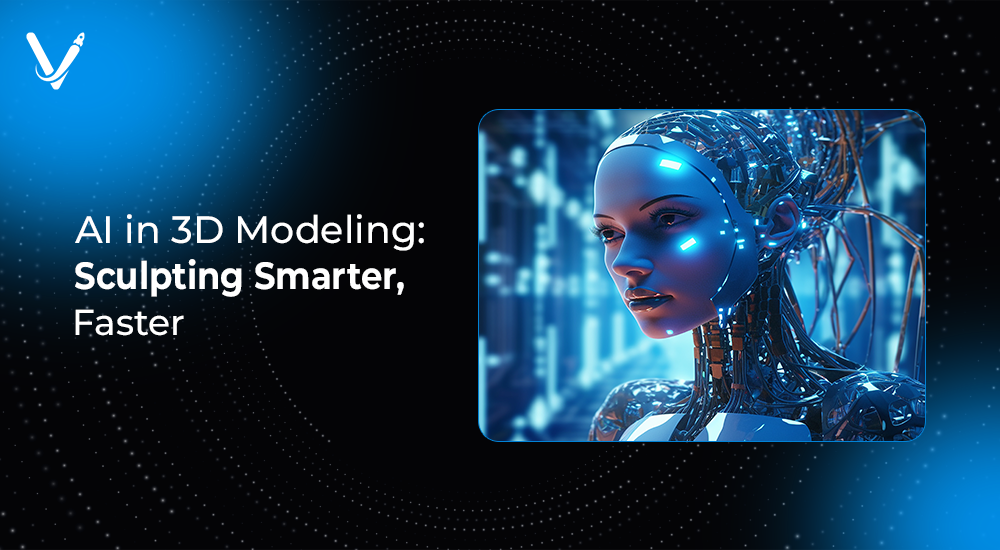AI in 3D Modeling: Sculpting Smarter, Faster


- Jun 30, 2025
3D modeling has long been a cornerstone of digital creativity, shaping everything from blockbuster films and AAA video games to architectural renderings and virtual product design. As demand for immersive experiences and hyper-realistic visuals continues to grow, so does the need for speed, efficiency, and innovation in the modeling process.
Enter Artificial Intelligence—a transformative force that is redefining the rules of 3D content creation. With the rise of AI-powered tools and intelligent design assistants, artists and developers are now sculpting smarter, not just faster. This article explores how AI is transforming 3D modeling workflows, empowering creatives with predictive automation, generative sculpting, and unprecedented precision.
We’ll break down the core AI technologies driving this shift, examine real-world use cases, spotlight industry tools, and offer insights into where this evolving synergy between AI and 3D modeling is headed.
AI in 3D modeling refers to the use of machine learning algorithms, neural networks, and computer vision to automate, enhance, and accelerate the 3D creation process. These intelligent systems are trained on vast datasets of objects, textures, and animations, enabling them to understand shapes, generate models, fill gaps, correct errors, and even imagine entirely new designs.
Instead of spending hours manually tweaking meshes or sculpting fine details, artists can now rely on AI to handle repetitive tasks, predict intent, or co-create assets that align with their artistic vision.
Key technologies enabling AI in 3D modeling:
Traditional 3D modeling requires extensive manual work—from mesh cleanups and UV unwrapping to rigging and texturing. AI automates many of these time-consuming processes.
For example:
This automation allows artists to focus on creative decisions while machines handle the grunt work.
Modern sculpting tools are integrating AI to enhance precision and user intent recognition. Tools like ZBrush’s Dynamics and Adobe Substance 3D Sampler leverage AI to predict strokes, simulate real-world material behavior, and suggest geometry enhancements in real time.
This leads to:
Generative AI models, trained on massive databases of 3D assets, can now create new models on demand. Artists can input simple prompts or sketches and receive AI-generated base meshes or textured objects, which can then be customized further.
Tools like Kaedim and Meshcapade use AI to convert 2D concepts or scans into detailed 3D meshes. These assets serve as a foundation, dramatically reducing the time needed for ideation and prototyping.
AI can apply textures, materials, and lighting presets across models using style transfer techniques. This lets artists switch between visual styles—such as photorealism, cel-shading, or stylized art—within seconds, without redoing textures from scratch.
Substance 3D uses AI to auto-generate texture maps based on material descriptors, enabling:
AI dramatically shortens asset production cycles in game development. Studios now rely on intelligent tools for:
Case in point: Ubisoft’s La Forge division uses deep learning for motion capture cleanup, reducing post-processing time by over 60%.
AI enables faster VFX pipelines by assisting in rotoscoping, scene reconstruction, and procedural modeling. Companies like Weta Digital use AI-powered simulation to model fluid dynamics and crowd behavior in large-scale scenes.
For example, Digital Domain used AI-driven tools to create photoreal digital doubles in blockbuster movies—streamlining facial modeling and emotion blending.
AI is helping architects visualize 3D structures from blueprints or sketches. Using neural rendering, tools like Spacemaker AI analyze spatial efficiency and generate optimized layouts.
In interior design, AI can:
3D product visualization is crucial for online retail. AI speeds up model creation by:
Platforms like CGTrader’s ARsenal and NexTech AR are integrating AI to scale 3D content creation for large product catalogs.
In healthcare, AI-generated anatomical models are used for:
AI algorithms can also transform MRI or CT scans into 3D reconstructions, improving diagnostic precision.
Kaedim: Converts concept art into production-ready 3D models using AI.
NVIDIA Omniverse: Offers AI-assisted simulation and collaboration for digital twins, games, and film.
Meshcapade: Uses AI to generate human avatars and animate them using motion capture.
Runway ML: Provides generative tools that assist in stylization and object creation.
Blender + GAN Plugins: Open-source community-driven AI integrations for procedural design and style transformation.
Despite its transformative potential, AI in 3D modeling still faces challenges:
Assess Your Current Pipeline: Identify bottlenecks in your modeling process where AI can help.
Choose the Right Tool: Select an AI tool based on your needs—mesh optimization, asset generation, or animation.
Train or Customize Models: If possible, train models on your own datasets for better alignment.
Test and Iterate: Integrate AI outputs in small batches, review quality, and adjust parameters.
Collaborate Across Teams: Involve artists, technical directors, and engineers for smooth adoption.
Scale Gradually: Start with asset creation, then move toward lighting, texturing, or animation support.
AI-Generated Worlds: Procedural generation of entire environments based on prompts, perfect for gaming and metaverse applications.
Real-Time 3D Content via Voice Commands: Imagine telling a tool, “Create a cartoon-style cat with a red backpack,” and receiving a base model instantly.
AI-Augmented Reality Creation: AI building AR-ready 3D assets that adapt in real time to user behavior and context.
Biologically Inspired Designs: AI drawing insights from nature to create efficient and organic models for architecture or fashion.
Ethical AI Artistry: A growing focus on tools that respect artist copyrights, promote inclusivity, and maintain creative integrity.
AI in 3D modeling isn’t about replacing artists—it’s about enhancing their creative freedom. By offloading repetitive tasks and offering intelligent suggestions, AI empowers artists to focus on storytelling, design, and innovation.
As tools become more accessible and intuitive, we’re entering a future where anyone can shape immersive 3D worlds with just an idea and a bit of imagination—backed by smart algorithms and real-time feedback.
At Vasundhara Infotech, we specialize in integrating AI into creative workflows—whether it’s game development, metaverse design, digital twins, or product visualization. Our expert teams blend artistry and engineering to help you build smarter and faster.
Ready to supercharge your 3D pipeline with AI? Let's build the future of design together. Book a free consultation today.
Copyright © 2025 Vasundhara Infotech. All Rights Reserved.
